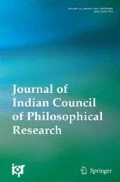Abstract
Aparigraha, the cardinal principle of Jainism, has been emphasized in the tradition, from its origin. One can rightly say that Ahiṁsā, the defining principle of Jainism, and Aparigraha go hand in hand. In the contemporary period, Ahiṁsā, Anekānta and Aparigraha have become a Trinity of Jainism for the World around. The discussions regarding Aparigraha are centered on the moral and spiritual aspects of the concept. Accordingly, Aparigraha is developed, first as Mahāvrata and then as Aṇuvrata; in both the senses, Aparigraha indicates the mental state of a person with high moral character marching toward spiritual goal in the first case and leading the life of a householder in the second case. Here is an attempt to explore another dimension of Aparigraha, viz. a rational dimension. So far a close relation between Ahiṁsā and Aparigraha has been expounded. This paper will make a humble attempt to bring out the equally close relation between Aparigraha and Anekānta. The articulation is done with a confidence that it will give a more promising look to Jainism in contemporary multi-religious society.
Similar content being viewed by others
Notes
The Jainism before Mahāvīra, i.e., the 24th Tīrthaṅkara in the tradition was the Religion based on four principles, viz. Non-violence, Truth, Non-stealing and Non-possessiveness. Till the 23rd TīrthankaraPārs̍vnātha, this was a moral-spiritual framework. This is known as the Caturyāma Dharma, i.e., religion based on four principles. Mahāvīra added the fifth principle, viz. Celibacy, and it became Pañcayāma Dharma, i.e., religion based on five principles.
Reality is defined in Jainism as having three features, viz. permanence, origination and destruction. ‘Utpādavyayadhrauvyayuktaṁ sat|’ (Tattvārtha sūtra, V. 30). This description of Reality as permanent-cum-changing can be vindicated only in the context of Anekāntavāda.
Contemporary scholars like B.K. Matilal and S. Gopalan are the notable names in this context. Dr. Matilal’s interpretation of Anekānta, in his book ‘Anekāntavāda: Jaina Philosophy of Non-Absolutism’, goes beyond the metaphysical context of the doctrine. S. Gopalan, in his book ‘Anekāntavāda: A Meta-philosophy’ has argued that it is not a metaphysical but a meta-philosophical doctrine.
It may be argued that the sociopolitical doctrine of Socialism is an attempt of accommodating the principle of Aparigraha in the modern times. However, it is difficult to show any affinity between Jainism and the materialistic doctrine of socialism.
Ācāraṅga Sūtra, 2.1.1, Jacobi (1994, p. 15).
Ācāraṅga Sūtra, 2.2.1, ibid, p. 17.
Ācāraṅga Sūtra, 2.5.3, ibid, p. 23.
Ācāraṅga Sūtra, 2.6.2 and 3, ibid, p. 26.
Ācāraṅga Sūtra, 2.6.5, ibid, p. 27.
Quoted by Johnson (1995, p. 32).
Tattvārtha Sūtra, 7.12, Sanghavi (2000, p. 269).
Tattvārtha Sūtra, 7.24, Sanghavi (2000, p. 279).
Sarvārthasiddhi on Tattvārtha Sūtra, 7.17.
Jaini (1979, p. 177).
Tatia (1998, p. 9).
Sanghavi (2000, p. 270).
Matilal (1981, p. 06).
von Glasenapp (1999, p. 231).
Ibid, p. 228.
References
Jacobi, H. (Trans.). (1994). Jaina Sutras, part I, the Ācārāṅga Sūtra & the Kalpa Sūtra. Delhi: Motilal Banarasidas.
Jaini, P. (1979). Jaina path of purification. Delhi: Motilal Banarasidas.
Johnson, W. J. (1995). Harmless souls. Delhi: Motilal Banarasidas.
Matilal, B. K. (1981). The central philosophy of Jainism (Anekānta-vāda). Ahmedabad: L.D. Institute of Indology.
Sanghavi, S. (2000). Tattvārtha Sūtra, Commentary by Pt. Sukhlalji (K. K. Dixit, Trans.). Ahmedabad: L.D. Institute of Indology.
Tatia, N. (1998). Lectures on Jainism. Chennai: Department of Jainology, University of Madras.
von Glasenapp, H. (1999). Jainism: An Indian religion of salvation (S. Shrotri, Eng. Trans.). Delhi: Motilal Banarasidas.
Author information
Authors and Affiliations
Corresponding author
Rights and permissions
About this article
Cite this article
Katarnikar, M. Aparigraha: Conceptual Understanding and Practical Application (Toward Exploring the Rational Dimension of Aparigraha). J. Indian Counc. Philos. Res. 35, 391–399 (2018). https://doi.org/10.1007/s40961-018-0139-9
Received:
Revised:
Accepted:
Published:
Issue Date:
DOI: https://doi.org/10.1007/s40961-018-0139-9




